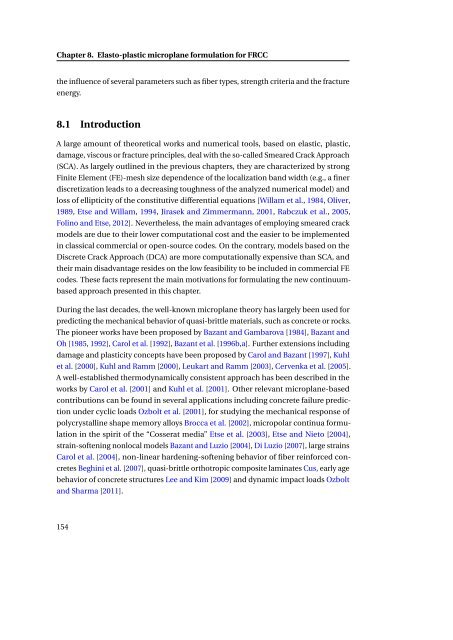tesi A. Caggiano.pdf - EleA@UniSA - Università degli Studi di Salerno
tesi A. Caggiano.pdf - EleA@UniSA - Università degli Studi di Salerno
tesi A. Caggiano.pdf - EleA@UniSA - Università degli Studi di Salerno
- No tags were found...
Create successful ePaper yourself
Turn your PDF publications into a flip-book with our unique Google optimized e-Paper software.
Chapter 8. Elasto-plastic microplane formulation for FRCCthe influence of several parameters such as fiber types, strength criteria and the fractureenergy.8.1 IntroductionA large amount of theoretical works and numerical tools, based on elastic, plastic,damage, viscous or fracture principles, deal with the so-called Smeared Crack Approach(SCA). As largely outlined in the previous chapters, they are characterized by strongFinite Element (FE)-mesh size dependence of the localization band width (e.g., a finer<strong>di</strong>scretization leads to a decreasing toughness of the analyzed numerical model) andloss of ellipticity of the constitutive <strong>di</strong>fferential equations [Willam et al., 1984, Oliver,1989, Etse and Willam, 1994, Jirasek and Zimmermann, 2001, Rabczuk et al., 2005,Folino and Etse, 2012]. Nevertheless, the main advantages of employing smeared crackmodels are due to their lower computational cost and the easier to be implemente<strong>di</strong>n classical commercial or open-source codes. On the contrary, models based on theDiscrete Crack Approach (DCA) are more computationally expensive than SCA, andtheir main <strong>di</strong>sadvantage resides on the low feasibility to be included in commercial FEcodes. These facts represent the main motivations for formulating the new continuumbasedapproach presented in this chapter.During the last decades, the well-known microplane theory has largely been used forpre<strong>di</strong>cting the mechanical behavior of quasi-brittle materials, such as concrete or rocks.The pioneer works have been proposed by Bazant and Gambarova [1984], Bazant andOh [1985, 1992], Carol et al. [1992], Bazant et al. [1996b,a]. Further extensions inclu<strong>di</strong>ngdamage and plasticity concepts have been proposed by Carol and Bazant [1997], Kuhlet al. [2000], Kuhl and Ramm [2000], Leukart and Ramm [2003], Cervenka et al. [2005].A well-established thermodynamically consistent approach has been described in theworks by Carol et al. [2001] and Kuhl et al. [2001]. Other relevant microplane-basedcontributions can be found in several applications inclu<strong>di</strong>ng concrete failure pre<strong>di</strong>ctionunder cyclic loads Ozbolt et al. [2001], for studying the mechanical response ofpolycrystalline shape memory alloys Brocca et al. [2002], micropolar continua formulationin the spirit of the “Cosserat me<strong>di</strong>a” Etse et al. [2003], Etse and Nieto [2004],strain-softening nonlocal models Bazant and Luzio [2004], Di Luzio [2007], large strainsCarol et al. [2004], non-linear hardening-softening behavior of fiber reinforced concretesBeghini et al. [2007], quasi-brittle orthotropic composite laminates Cus, early agebehavior of concrete structures Lee and Kim [2009] and dynamic impact loads Ozboltand Sharma [2011].154
















